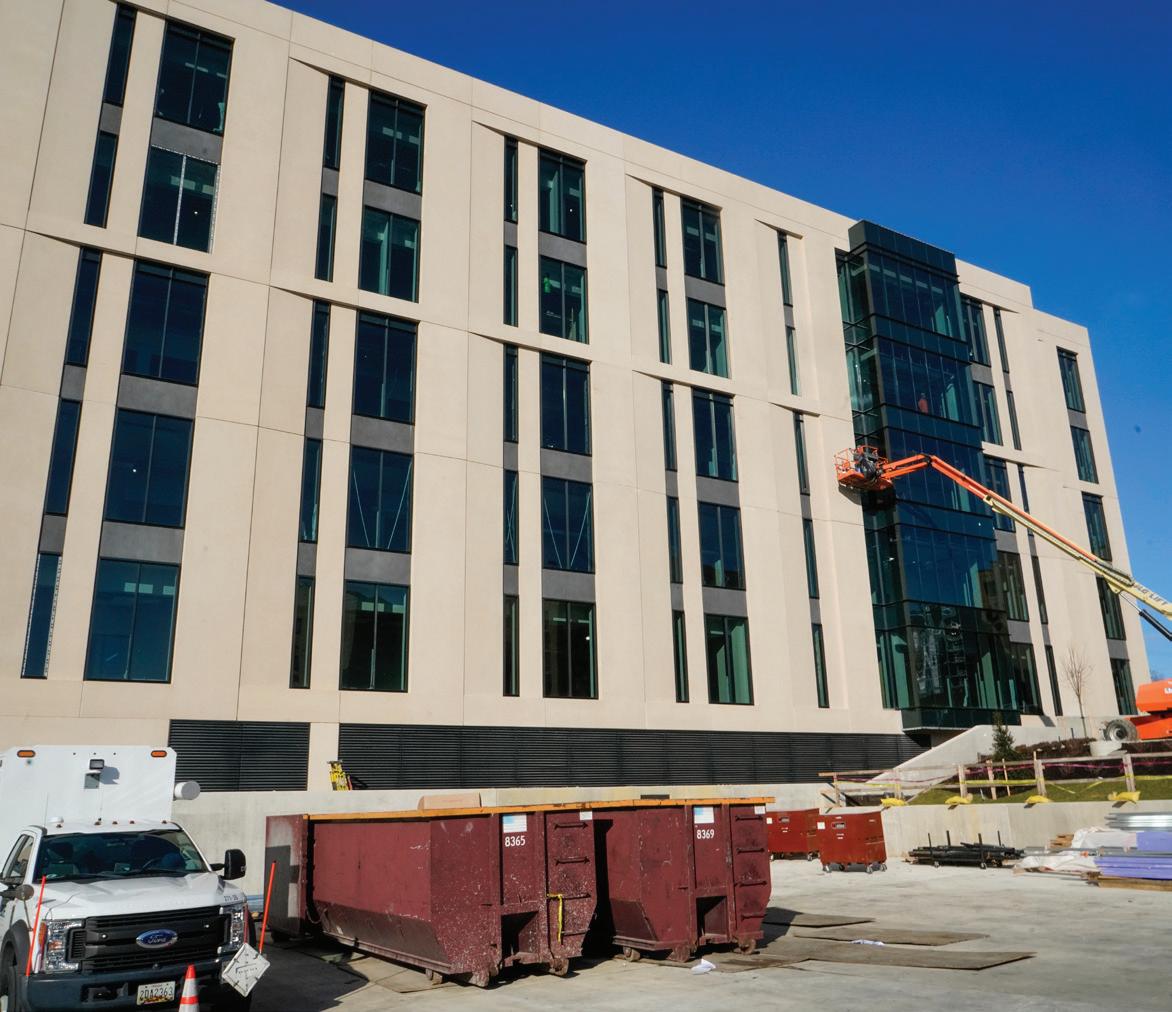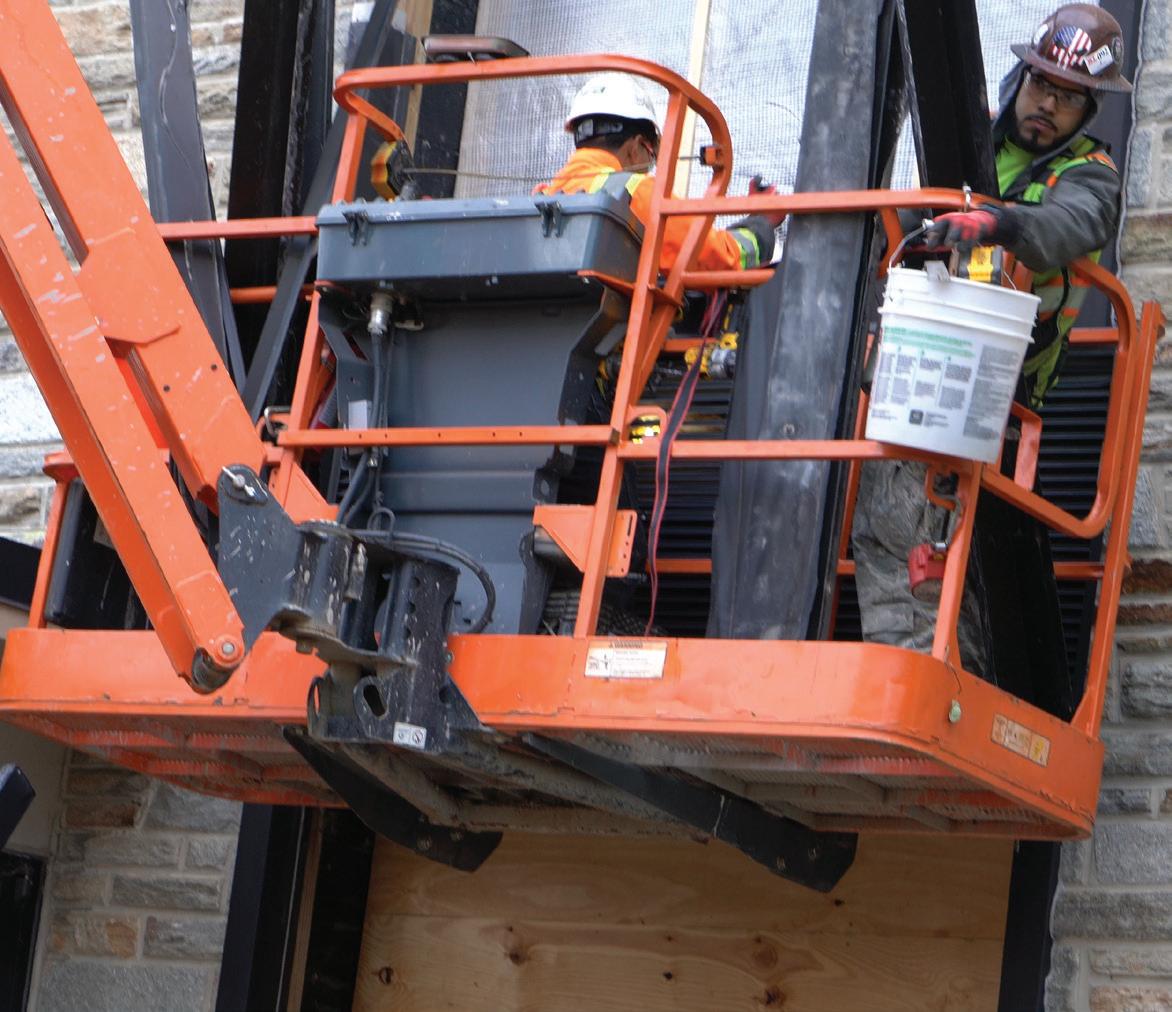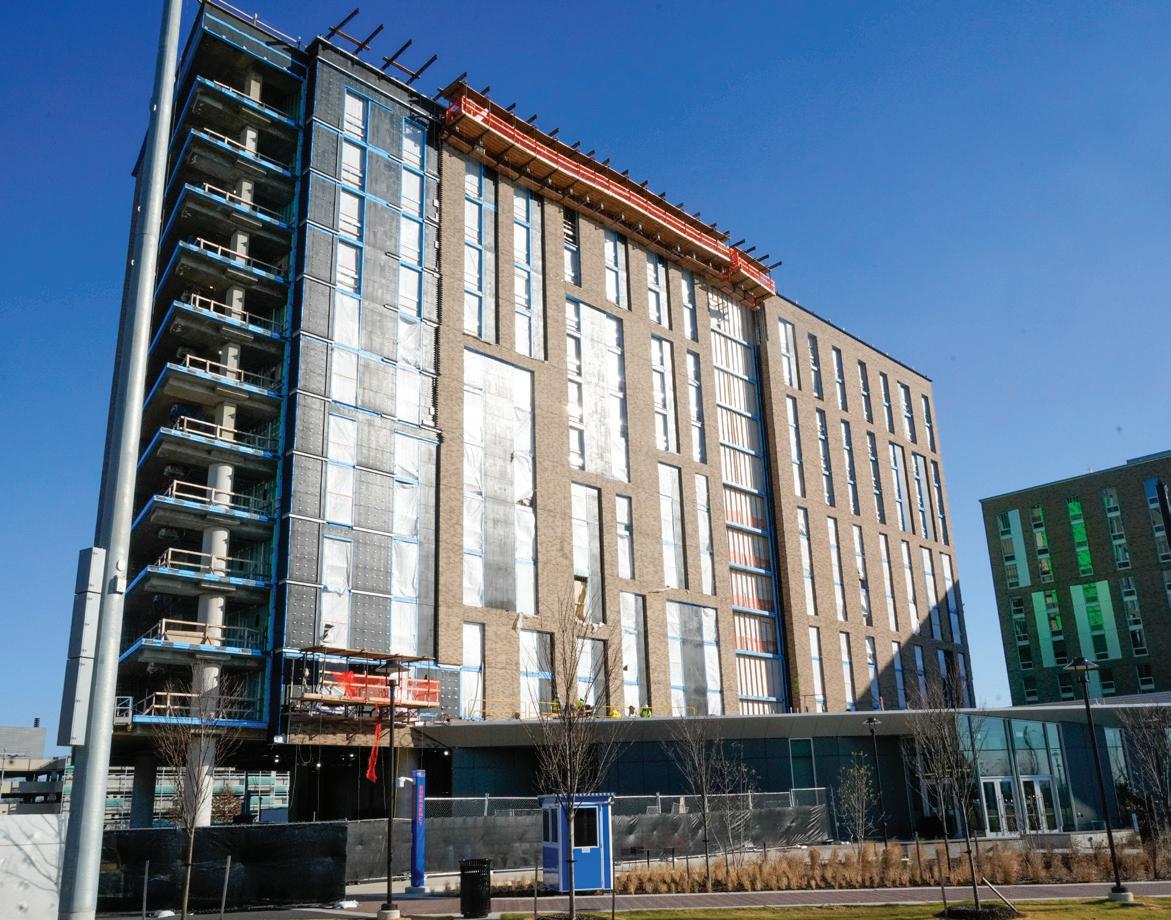Future Health and Human Services Building



House Appropriations Committee
Delegate Benjamin S. Barnes, Chair
Capital Budget Subcommittee
Delegate Mark S. Chang, Chair
March 4, 2024
Senate Budget and Taxation Committee
Senator Guy Guzzone, Chair
Capital Budget Subcommittee
Senator Craig J. Zucker, Chair
March 5, 2024
Dr. David K. Wilson, President
Dr. David Kwabena Wilson
President
Dr. Hongtao Yu
The Honorable Kweisi Mfume, Chair
Gen. Larry R. Ellis (Ret.), Vice Chair
The Honorable Tracey L. Parker-Warren, Secretary
Ms. Swati Agrawal
Ms. Paityn-Amor Brooks, Student Regent
The Rev. Dr. Harold A. Carter Jr.
Dr. Linda J. Gilliam
Dr. Burney J. Hollis
Ms. Emily M. Hunter
Dr. Shirley M. Malcom
Mr. Brian D. Pieninck
Mr. William A. Sherman II, Esq.
Ms. Shelonda D. Stokes
Mr. Carl W. Turnipseed
Mr. Winston A. Wilkinson
Provost and Senior Vice President, Academic Affairs
Dr. Kevin Banks
Vice President, Student Affairs
Ms. Endia DeCordova
Vice President, Institutional Advancement
Ms. Dena Freeman-Patton
Vice President and Director, Intercollegiate Athletics
Ms. Julie Goodwin
General Counsel
Ms. Armada Grant
Special Assistant to the President
Mr. David LaChina
Executive Vice President, Finance and Administration (Interim)
Mr. Abraham Mauer
Director, Internal Audit and Management Review
Dr. Willie E. May
Vice President, Research and Economic Development
Ms. Kim I. McCalla
Vice President for Facilities, Design and Construction Management
Dr. Cynthia Mendoza
Vice President/Chief Information Officer, Division of Information Technology (Interim)
Dr. Kara M. Turner
Vice President, Enrollment Management and Student Success
Dr. Don-Terry Veal
Vice President, State and Federal Relations and Chief of Staff
Fiscal Year 2025 Capital Budget
Morgan State University
David K. Wilson, PresidentMarch 2024
Chair and members of the Subcommittee, thank you for the opportunity to testify on the Governor’s fiscal year 2025 capital budget allowance for Morgan State University.
First, I thank Governor Moore for his support of higher education and, specifically, his support for Morgan. I also thank the members of this Committee for your strong and continued support of Morgan State University. Our analyst, Ms. Kelly Norton, has done an outstanding job of analyzing our budget, and I will respond to her comments and recommendations as a part of my testimony.
Morgan State University is the Preeminent Public Urban Research University in Maryland, known for our excellence in teaching, intensive research, effective public service, and community engagement. Morgan prepares diverse and competitive graduates for success in a global, interdependent society.
Morgan State University serves the community, region, state, nation, and the world as an intellectual and creative resource by supporting, empowering, and preparing high-quality, diverse graduates to lead the world. The University offers innovative, inclusive, and distinctive educational experiences to a broad cross-section of the population in a comprehensive range of disciplines at the baccalaureate, master's, doctoral, and professional degree levels. Through collaborative pursuits, scholarly research, creative endeavors, and dedicated public service, the University gives significant priority to addressing societal problems, particularly those prevalent in urban communities.
The continued fulfillment of our vision and mission is being realized through our Strategic Plan, Transformation Morgan 2030: Leading the Future. The Plan details the University’s approach to continued growth and advancement and is guided by six strategic goals:

Building on our nearly 157-year reputation of preparing leaders, the University has already made tremendous strides in the accomplishment of these strategic goals. The University has had record-breaking enrollments for three consecutive years, with 9,808 matriculants in Fall 2023, an 8% growth from the Fall 2022 enrollment of 9,101. Enrollment has increased more than 28% since 2020, bringing us to a total of fewer than 200 students shy of our projected enrollment for 2030 Increased retention and graduation rates and the national recognition our students are receiving through various awards and other honors provide evidence of the success our students are achieving Recent awarding organizations include the White House HBCU Initiative, the Obama Foundation, the Kirchner Foundation, the William & Lanaea C. Featherstone Foundation, and the 2023 University Innovation Fellows Program run by Stanford University. Supporting their success, our students are increasingly participating in programs aimed at promoting wellness, such as Uwill, Wellness Days, and other programs sponsored by our Division of Student Affairs. Unique and expanded academic programs contribute to our appeal and solidify our status as a world-class institution. We have introduced more than 30 new academic programs since 2020. Most recently, approval was received for our Ph.D. program in Integrated Materials Science and an M.S. in Biomedical Science. We launched our College of Interdisciplinary and Continuing Studies (CICS) in Fall 2021 to provide a pathway to degree attainment for non-traditional students who have previously earned college credits but stopped short of receiving their degree CICS has since added 18 interdisciplinary degree programs through our “Morgan Completes You'' Program, which has doubled in enrollment since last year. The new Degrees to Succeed Program was implemented through our partnership with the Community College of Baltimore County, providing dual admission to students, increasing associate degree attainment, and accelerating undergraduate degree completion.
We are attracting the best and brightest faculty. Eight current Morgan faculty are ranked among the World’s Top 2% of Scientists. Our dean of Engineering is the 2024 American Society of Mechanical Engineers Edwin F. Church Medal recipient. He is the first African American to receive this distinguished award in its 52-year history. Our vice president for Research and Economic Development serves as the American Association for the Advancement of Science (AAAS) president-elect, after which he will serve as AAAS president and as chair of the Association’s Annual Meeting in 2025. Clearly, we are attracting the best and the brightest.

Research and grant income and expenditures are growing at our R-2 (high research) institution, moving us closer to our goal of attaining the R1 (very high research) Carnegie Classification. During FY 2023, Morgan received $100.8 million in grants, contracts, and gifts, in addition to a $27-million Indefinite Delivery, Indefinite Quantity (IDIQ) contract with the National Institute of Standards and Technology (NIST). The IDIQ is a five-year agreement through which Morgan is contributing to the diversification of the STEM workforce and expanding opportunities for underrepresented minorities by leading a consortium of fellow HBCUs in placing students in research programs at NIST. The National Science Foundation (NSF) has awarded Morgan State University a nearly $3-million grant to establish an NSF Research Traineeship program in Artificial Intelligence for Climate Change and Environmental Sustainability (ACCESS). This program is designed to provide hands-on training for the next generation of scientists and engineers researching artificial intelligence and machine learning solutions to wide-ranging climate change impacts. Funded over the next five years, the ACCESS program will train nearly 50 Ph.D students, including 25 funded trainees from diverse scientific fields, including bioenvironmental science, mathematics education, engineering, and computer science. Students largely underrepresented in STEM research of this caliber will gain a critical multidisciplinary understanding of how AI can provide solutions for changing climate, environmental pollution, and water quality management. Building on our reputation as a respected research university, the Governor’s FY 2025 budget includes an annual appropriation of $3 million for the establishment of the Center for Urban and Coastal Climate Science Research, Morgan’s 10th State-funded research center
Our international footprint is growing, not only with the number of international students on our nationally recognized campus designated at National Treasure, but also through study abroad opportunities being afforded our students. In addition, Morgan continues to lead all HBCUs in the number of students, faculty and administrators who have earned Fulbright awards. In 2023, Morgan was named a Fulbright Historically Black College and University (HBCU) Institutional Leader for the fourth consecutive year.
New contemporary and expanded academic programs, growing research grants and expenditures, increasing global footprint, and world-class faculty are all affirming our position as a premier anchor institution in the city of Baltimore and beyond. As an anchor institution, our interest is not only in our students, faculty, and staff but also in the communities we serve. Our presence and influence were the impetus behind the recent redevelopment of the Northwood Plaza Shopping Center rebranded as Northwood Commons. Contiguous to our West Campus and completed through public/private partnerships, the redevelopment provides attractive, quality businesses where patrons can shop and feel safe. Included in the redevelopment was the construction of our new Police and Public Safety facility and Morgan’s Barnes & Noble bookstore, which anchor the shopping center to the east. We are also locating community-based research centers off-campus, where they can better serve and be a stabilizing factor in the community. Through the support and collaboration of state, local, federal, and
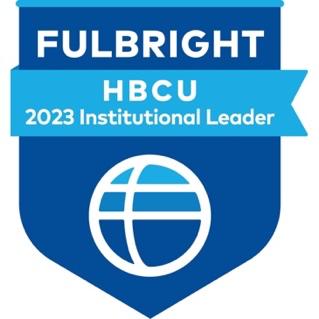
private entities, and through dedicated, focused leadership, we are achieving academic preeminence and becoming increasingly recognized as a leading world-class institution.
Critical to our continued growth and ascendency are state-of-the-art learning environments that simulate real-life work environments and enable our students to receive experiential learning and engage in meaningful research along with faculty. Facilities such as the Center for the Built Environment and Infrastructure Studies, the Morgan Business Center, and Tyler Hall attract students, faculty, and research dollars and have been instrumental in the development of strategic partnerships with public and private institutions such as Purdue, Yale, Dartmouth, Harvard, Johns Hopkins, Bank of America, Apple, Ripple, and Google. These partnerships provide our students and faculty with unparalleled learning and research opportunities.

• Center for the Built Environment and Infrastructure Studies (CBEIS), constructed in 2012, is home to our School of Architecture and Planning; Civil Engineering and Transportation and Urban Infrastructure Studies programs; as well as leading research centers including the National Transportation Center (NTC) and the Urban Mobility and Equity Center (UMEC). UMEC is one of 35 research centers funded by the U.S. Department of Transportation and one of two Tier-1 centers at HBCUs nationwide. Morgan has been selected to collaborate in a national, multi-university consortium focused on ensuring that autonomous, networked, shared, and integrated transportation technologies and systems are developed and deployed with an emphasis on safety, equity, and sustainability. Led by Carnegie Mellon University, the consortium, collectively, will receive $20 million over the next five years from the U.S. Department of Transportation to establish Safety21, a new University Transportation Center (UTC). For its part, Morgan will receive $1.5 million to research where and how landslides may occur along highways and roads, using geomechanics analysis and artificial intelligence/machine learning methodologies. In addition, the Morgan State University National Center for Transportation Management, Research and Development has further secured its position as one of the nation’s foremost transportation research authorities, with the recent receipt of a $15-million grant from the U.S. Department of Transportation. The announced round of federal funding is part of an extensive Biden administration commitment to upscale transportation innovation and research as well as invest in vital training for a diverse next generation of transportation leaders.
• Morgan Business Center, opened in 2015, is the home of the Earl G. Graves School of Business and Management (GSBM), which is among the 5% of schools worldwide accredited by the Association to Advance Collegiate Schools of Business International (AACSB). We also have the distinction of being the first HBCU to receive the endorsement of the Institute of Management Accountants, one of the largest and most respected associations focused exclusively on advancing the management accounting profession. With outstanding faculty, and such features as a Capital Markets Lab and a Business Incubator for entrepreneurship training, the GSBM is attracting private and public investment that are increasing the school’s impact both inside and outside of Morgan. Through participation in the Goldman Sachs 10,000 Small Businesses Program, 460 entrepreneurs have graduated from the national entrepreneurship development program. The GSBM also houses the Center for Data Analytics and Sports Gaming Research, which is focused on informing and educating students in data analytics and its uses in sports; the Morgan Innovation and Entrepreneurship Center; and the National Fintech Center, established through a multimillion-dollar grant from Ripple, a Silicon Valley-based technology company. The Fintech Center actively engages faculty and students at all HBCUs in research, curriculum development, and education in blockchain and fintech

• Martin D. Jenkins Behavioral and Social Sciences Building (BSSC) opened in 2017 and is home to the James H. Gilliam Jr. College of Liberal Arts. It features state-of-the-art facilities, including a Forensic Anthropology lab, Psychology labs, a Vivarium, and observation rooms to support Morgan State University scholars conducting groundbreaking research. Equipped and staffed according to the American Association for Accreditation of Laboratory Animal Care standards, the Vivarium enables researchers to utilize laboratory animals in an innovative, ethical, and humane manner to advance scientific knowledge. The dean of the College of Liberal Arts was recently awarded the distinction of Honorary Professor of Literature and Translation by the Universidad Ricardo Palma in Lima, Peru, and one of our outstanding professors was named as one of three new members of the Board of Directors of American Rivers, one of the premier national organizations focused on clean water and river health.
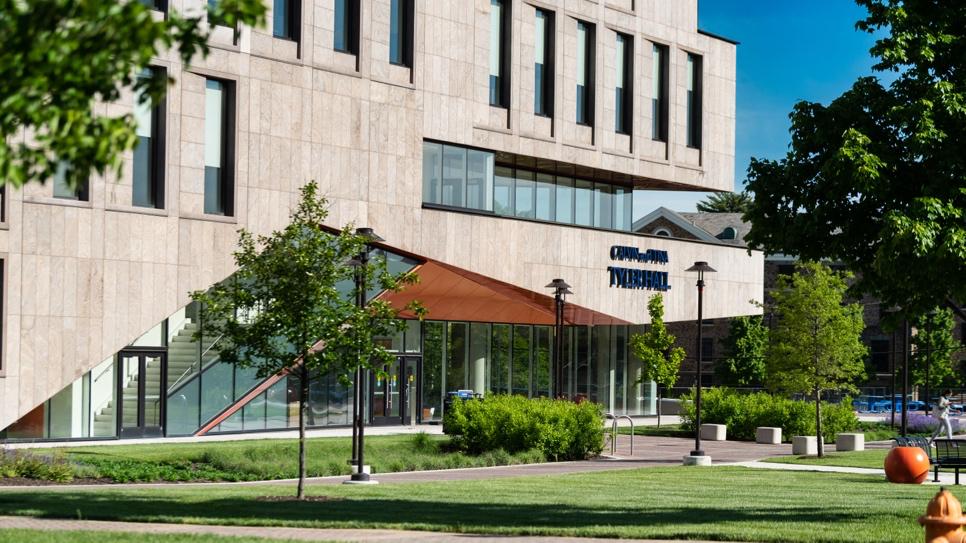
• Our newest facility, Calvin and Tina Tyler Hall, opened in Fall 2020, housing departments such as Admissions, Records and Registration, Financial Aid, Bursar, Human Resources, and Information Technology. Tyler Hall is the front door of our campus, welcoming students, parents, and prospective employees to our university. It features a three-story atrium off its lobby, dramatic interior and exterior angles, a contemporary recruitment room, an accessible “green roof” with multiple gathering “pods,” numerous department suites with diverse office concepts, and modern technology throughout, including mounted display walls and videoconferencing capabilities. The new facility features Bear Essentials, a onestop student services center dedicated to assisting students on their journey from admission to graduation.
Record-breaking enrollments, growing grants and contracts, and increased collaborations do not come without challenges. We are fewer than 200 students short of the enrollment we had projected for 2030, and that and associated demands, coupled with the aging of a number of our facilities, is putting a strain on our capacity. The University is leasing off-campus housing and facilities to accommodate students and programs. The new Health and Human Services Building which will house the School of Community Health and Policy, including Public Health, Nutrition Sciences, Nursing, Pre-Professional Physical Therapy, and Health Education; the School of Social Work; the Department of Family and Consumer Sciences; and Medical Technology will be opening this fall, as will Thurgood Marshall Hall II, a new housing unit that will accommodate 604 students. Thurgood Marshall Hall I, II (Legacy Hall), and their dining hall were constructed in partnership with the Maryland Economic Development Corporation (MEDCO). In addition, we have developed a strategic housing plan that includes renovations and replacement. Two residential halls Baldwin Hall and Cummings House are now undergoing renovation and will also be available in the fall. Hurt Gymnasium is also in the process of a major renovation. In addition, our new Police and Public Safety facility was constructed and was opened in 2022. These projects were funded through the HBCU Cap Fin Loan program, federal funds (HEERF and Covid), the Maryland Clean Energy Center (MCEC), and Siemens. Improvements were also made to the Gilliam Concert Hall and Recital Halls at our Murphy Fine Arts Center, and air quality upgrades were made to various other buildings. Much has been accomplished, but continuing investment is needed to meet growing and evolving campus needs and to advance the University
The Governor’s capital budget allowance for Morgan is $37,740,000 in GO Bonds.
New
Lake Clifton
Carter-Grant-Wilson Renovation
Key: C – Construc/on, E – Equipment, P – Planning, O – Other
Deferred Maintenance
This request provides funds to continue renovating, repairing, and upgrading building systems and infrastructure to address the significant deferred maintenance backlog. The backlog is estimated at between $150 million and $200 million. The University is augmenting the State’s investment in its campus facilities through the operating budget, federal HBCU Capital Financing Program loan funding, Energy Performance Contracts (EPC), and two grants from the National Park Service for repairs to the University Memorial Chapel. The FY 2025 funding is for Murphy Fine Arts Roof and Exterior Door Replacements ($2,081,000), for Concrete Steps and Handrails ($850,000), and for Replacement of Obligated Funds ($2,069,000).
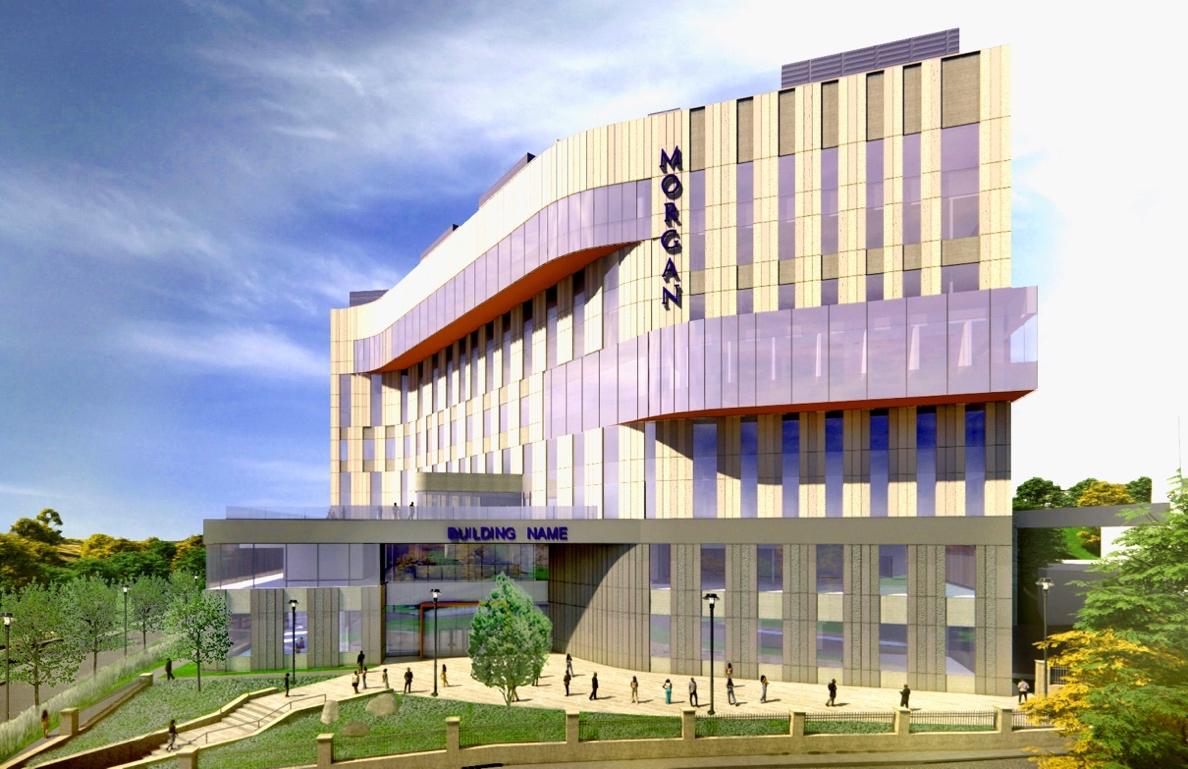
Science and Research Complex
This funding provides additional design and construction funding for the new Science and Research Complex, housing our Biology and Chemistry Departments and office for the dean of the School of Computer, Mathematical and Natural Sciences, on the site of the existing Washington Service Center. The amount included in the Governor’s budget is far less than we requested, because:
1. Department of Budget and Management’s (DBM) overall estimated project cost is significantly lower than the architectural and engineering team’s (A/E’s) and the construction manager’s. Both the A/E and construction manager estimate a total project cost of $342,000,000 vs. DBM’s estimate of $264,294,000.
2. DBM’s schedule is based on a later construction start day than ours.
Because of our concern that the planned funding is inadequate, the University has made every effort to reduce costs without sacrificing the integrity of the project. Reductions have been made to the square footage of class laboratories and offices and the quality of finishes. Even so, we believe we will have to shell out approximately 140,000 gross square feet, approximately 60% of the facility, if additional funding is not provided. Further complicating the funding concern is the fact that our student enrollment in these disciplines has grown such that we have already exceeded the programmed enrollment projections, accordingly the building is already too small. Aware of this, DBM requested that we perform a new guideline analysis based on current enrollments and develop a program modification. The guideline analysis, which used Fall 2022 data, revealed that when the new building opens, we will be deficient by more than 60,000 net assignable square feet, which equates to an additional 109,200 gross square feet. It is not feasible to modify the program to accommodate this massive shortfall at this phase of the project; thus, we will look to accommodate it in a future project. We will also analyze to see if there are any changes that should be made to better the needs of the programs earmarked for this facility and our growing research needs.
This funding provides additional design and construction funds for the demolition of Lake Clifton High School and the stabilization of the historic Valve House. The solicitation for design/demolition is being prepare for advertisement.
This funding provides for additional design and the first phase of construction and equipment for the comprehensive renovation of Carter-Grant-Wilson (“CGW”), including replacing all mechanical electrical, heating, and airconditioning systems with energyefficient systems; replacing the finishes, landscaping, and hardscaping; reconfiguring walls as necessary; and making repairs to the exterior skin of the building. The building and access will be renovated to meet current building codes and ADA accessibility. CGW is being renovated to provide space for our Graduate School and our International Affairs Division, both of which were located in facilities that are to be demolished and both of which are now in surge space. Design proposals have been received, and we intend to start design in April.

In closing, I once again express my deep appreciation for your ongoing support of Morgan’s Capital Improvement Program. Facilities make the initial impression on prospective students, faculty, and staff. Your investment is transforming the campus, helping to produce competitive, capable students, and attracting investments from the public and private sectors. We look forward to your continued support as we strive to provide state-of-the-art, meaningful learning environments for our students in every area of study and as we continue our work to advance our research and outreach missions. I, therefore, request your support of the Governor’s recommendation for our FY 2025 capital budget allowance.
Comment 1 (Page 5): The President should address the discrepancy in the cost estimates and plans to deal with this nearly $80 million difference.
Response: Morgan is doing all it can to reduce the cost of this project. The initial estimate was $110 million over the budgeted amount, and thus far, we have eliminated features totaling $30 million so that now we are $80 million over. We are very concerned that further reductions will significantly reduce program space and impact our ability to meet the basic science requirements of the students and faculty. We realize that no additional funds are available for the upcoming fiscal year but hope that additional funds can be allocated in the out-years, in order to maintain the viability of some of our fastest-growing programs.
As noted, the current discrepancy between the budget and cost estimate is $80 million. To arrive at our cost estimate, Morgan had several estimates commissioned by the architectural and engineering (AE) and the construction management teams. The construction management (CM) team works with contractors that have the capability to handle this size and type of project. This provides for more accurate cost estimates than those developed primarily using historical data. Both teams then collaborate and come to an agreed-upon amount. Subsequently, value engineering (VE) is performed to remove “nice-to-have” items as opposed to “items of necessity,” including verification of square footages to ensure they are within the program tolerances. Sometimes, removing or changing items to reduce costs changes the efficiencies of the building, including reducing energy efficiencies, making it more difficult to comply with the Governor’s executive order aimed at reducing greenhouse gas emissions. To achieve the initial reduction of $30 million, reductions were made in materials, equipment, office sizes (e.g., by replacing offices with cubicles), the number of windows (which, while less costly on the front end, is more expensive operationally, because we end up using more lighting, since less natural light will be available), etc., in an effort to maintain the current funding request. In addition, and new to Morgan, the CM team will be utilizing what is called “design assist,” where key trades are brought on during the design phase to work out coordination, phasing, size/fit, and other areas that typically cause changes during the construction. This process eliminates some of the changes and unknowns ahead of time. When possible, spaces have been set up so they could be dual-purposed (i.e., a large, flat lecture hall in lieu of a tiered lecture hall), allowing for other functions and differing setups to accommodate different modalities of instruction. In addition, we continue to weigh the impacts of first costs (construction costs) versus operational costs and efficiencies of other potential material and equipment reductions or modifications
As a part of our due diligence, Morgan investigated R1 universities (with similar levels of research components) and found that our estimated $915 cost per square foot was slightly below the average cost of construction projects at these institutions, which was at $918 per square foot
(sf). Meeting the R1 classification requirements for a building performing research necessitates additional infrastructure, which adds cost. These requirements include, but are not limited to, doubling the capacity of the emergency generator (with a separate generator), ensuring vibrations are not transmitted to certain areas (which requires a denser structure), and adding safety mechanisms to the piping throughout the building that are not normally required but that are necessary for the electrical, water, air, gas, and other systems supporting instruction and research in these disciplines.
To further reduce the $80-million cost overage, it would be necessary to shell out approximately 140,000 gross square feet (gsf) of research and academic space, rendering them unusable. Returning to finish the spaces at a later date would be more costly. Another option is to reduce the building by approximately 38,000 gsf of space; this would mean entire programs would have to be eliminated, such as chemistry or biology research, all chemistry academic programs and offices, or half of the biology academic programs and offices. Any of these options would negatively affect the accreditation of the science program. After positive trending for the past years, Morgan nearly met its 2030 enrollment projection of 10,000 students in 2023, with an enrollment of 9,808, and at the request of DBM revised the space guideline allowance, and determined the building will be more than 60,000 net assignable square feet (nasf)/109,200 gsf short of the space required to accommodate the programs just to meet today’s needs. This space will be required in a separate building. All students, regardless of major, are required to take math and science as a part of the general education requirements. This, too, adds to the need for space.
Timing is also important, as some systems, particularly electrical systems, take more than two years to arrive (once the order is placed), which means they must be identified and ordered early on in the process to avoid delays in the project. As the design progresses, Morgan will continue to look for opportunities to reduce costs, including ordering equipment and materials that have long lead items early which also helps reduce costs. The project is at a stage where hard decisions must be made on whether to make drastic reductions to the building and programs or to proceed with the anticipation of additional funds in the upcoming fiscal years
Comment 2 (Page 6): The committees requested in the 2023 Joint Chairmen’s Report that MSU provide a report by December 15, 2023, that outlines the redevelopment scope, identifies the stakeholders, provides the estimated cost and fund sources, and provides the anticipated project timeline. That report has not been submitted.
Response: We submitted our strategy for the development of Lake Clifton in our response of February 23, 2024. As indicated, Morgan is taking a multi-pronged approach to developing the Plan for Lake Clifton. These actions include updating the main campus master plan, which includes a determination of the types of programs/functions that should be located at Lake Clifton, securing a master development plan consultant to lead the development plan, hiring a contractor to demolish the school building, working with the community and Baltimore City Planning to set community development goals, hiring an architect to preserve the historic Valve House (additional program information is required by DBM), and collaborating with federal partners for current and future research programs on the site. As an aside, the nonprofit farm and the use of the football field by the local school remain active
Comment 3 (Page 7): The President should comment on the status of the other fiscal 2023 deferred maintenance projects and the anticipated timeline for encumbering and expending the $30 million provided in fiscal 2023.
Response: We are waiting to receive the proposals for the slope stabilization project. It is anticipated to cost between $10 and $15 million. Procurement recently released the requests for proposals; proposals are currently due in April with the anticipation of going to the BPW for approval in late May, 2024.
Morgan is also awaiting approval from DBM to utilize deferred maintenance funds for Phase II of the Academic Steam project and the replacement of the broken McMechen (Academic Quad) chilled water line. These projects cost $6,200,000. Because of the urgency of the projects, the design team and contractor were advised to concentrate on Phase I, which was the most critical portion of the steam system (the transmission (main) lines), to be followed by the branch lines (lines to the buildings). Unit rates from Phase I were utilized to determine the costs for Phase II and the chilled water. A program modification was required to replace the chilled water (the temporary line was piped above grade). Since the steam line was in the same location as the chilled water line, it was determined to be more economical to replace them both at the same time since the stairs, railings and walls were already removed for the steam work. As the project could not wait for DBMs approval, Morgan utilized the HBCU loan funds to advance the work while the approval was being sought. Morgan continues to hope the project funds will be reimbursed upon approval.
Other FY 2023 projects include but are not limited to:
• Repair of the three remaining boilers in the central heating plant: $3,000,000.
• Fire alarm upgrades/replacement, Phase II throughout campus: $4,700,000.
• Chapel roof system replacement and wall repairs: the project received a $500,000 grant from the National Park Service. The balance of the anticipated project cost will be paid from deferred maintenance funds in the approximate amount of $2,000,000. This project is in design.
Recommendation 1 (Page 2): Approve all authorizations, preauthorizations, and amendments to prior authorizations for Morgan State University.
Response: The University concurs with the Governor’s Allowance
